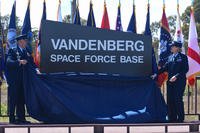MAXWELL AIR FORCE BASE, Ala. -- More than eight years in the making, a new database containing information from U.S. military and coalition aerial bombing campaigns over the last century is now publicly available online.
An historical data collection project developed and researched by Lt. Col. Jenns Robertson, the Theater History of Operations Reports database, or THOR, has evolved into a full-scale research tool available online at http://afri.au.af.mil/thor/index.asp.
The database combines digitized paper mission reports starting with World War I to create a central source of bombing history around the globe. The database can be searched by date, conflict or even aircraft-specific criteria, and organized into spreadsheets, charts or onto maps, forming a live-action sequence of events.
The THOR database is useful not only for current and future military commanders, Robertson said, but also for academic researchers, historians and government agencies involved in unexploded ordnance cleanup efforts.
"The most exciting part is that I can't envision all the ways this can be used," Robertson said. "This is a data trove that allows us to look over the last 70-100 years of bombing data, how we've conducted wars for the last century using airpower, and if we can't pull lessons out of that, then we're not doing our job."
Currently, the public can access data, including 58 different aircraft, bomb information, and even altitude, from World Wars I and II and Vietnam. The records from World War II and Vietnam are the most complete, he said, and include U.S. and Royal Air Force data, as well as some Australian, New Zealand and South African air force missions.
"We've tried to have all air forces, to make sure that it is an airpower view versus just a (U.S.) Air Force view, so joint, coalition data is our goal," explained Robertson.
Korea, he added, will be included on THOR, but record keeping during that time was done by hand due to changing technology.
"Everything was done free-text, not punch-card text or digitally, so we have to read the reports to pull the context out in order to get the data," he said.
Robertson began the project in 2006 when his military duties required him to create weekly briefings of current bombing activity. Realizing that it was taking longer than necessary to gather information from multiple resources, Robertson wanted to create a centralized source of information for military commanders to use. The need for a single information pool on current missions expanded into Robertson's goal of building an entire airpower collection dating back to World War I. During his off-duty time, Robertson spent the next five years decoding almost four million Vietnam War entries gathered from the National Archives in Washington, D.C.
When he was assigned to the Air Force Research Institute here to work exclusively on THOR, Robertson was able to locate strategic bombing information from WWII and battlefield raid reports from WWI, further adding to the database.
"We're still hunting for some of the data, and I don't know if we'll ever find it. You ask and you hunt and oftentimes we get lucky and find a trove like in the halls of the Air Force Historical Research Agency where I ran across the bombing survey books that had been untouched for 70 years," Robertson said.
Although the THOR website is just now publicly available, the database has already proved helpful, most recently by the Vietnamese government, which is using the Vietnam conflict data to assess post-war bomb and mine contamination in the Southeast Asia region.
"We can show that they have actually been able to save lives and prevent casualties since they originally got the data back in 2010, and the data that we've been able to give them has been even better, so hopefully we'll improve their chances of lowering exposure to explosives," Robertson said. "To be told, and to find out from the folks that are doing the demining in the field, that the data that was sent to them made them more effective. It's an incredible feeling to get that feedback that what you're doing is important."
From the time the Minnesota native arrived at the Air Force Research Institute, he and THOR team members John Conway and computer programmer Billy Barth have been working to get the data online for public use. Robertson said part of the goal of putting THOR on a public website is to have the best and brightest academics and historians fill in the gaps in official documents and correct inaccurate data whenever necessary.
"The professors at the various universities who teach and are writing books and doing research, we want to provide them access to this resource so they can give us the feedback of whether or not we've got it right," Robertson said. "I suspect there are errors still uncovered within the system that I cannot discover because I don't have the knowledge base myself, but, if I put it out there for the experts to examine, we can make it a better resource faster than relying on me working by myself or just a small crowd of us within the (Department of Defense). I look forward to seeing the response and see how we can make the database better for them."

























